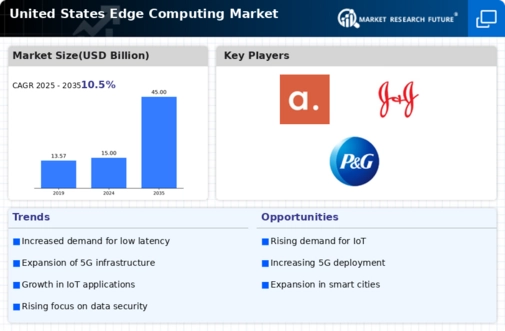Emergence of Edge AI Solutions
The emergence of edge AI solutions is a transformative driver for the edge computing market. By integrating artificial intelligence capabilities at the edge, organizations can enhance their data processing capabilities and derive actionable insights in real-time. This trend is particularly relevant in sectors such as retail, healthcare, and transportation, where immediate decision-making is crucial. The edge computing market is witnessing a shift towards AI-driven applications that can operate independently of centralized cloud resources. This decentralization not only improves response times but also reduces bandwidth costs associated with data transmission. As businesses increasingly recognize the value of edge AI, the market is projected to grow substantially, with estimates indicating a potential market size of $15 billion by 2026. This growth reflects the increasing reliance on intelligent systems that can operate efficiently at the edge.
Expansion of 5G Network Infrastructure
The rollout of 5G network infrastructure is a pivotal driver for the edge computing market. With its promise of ultra-low latency and high-speed connectivity, 5G enables a new era of applications that require immediate data processing. Industries such as autonomous vehicles, smart cities, and augmented reality are increasingly reliant on the capabilities offered by 5G networks. The edge computing market is expected to benefit immensely from this expansion, as it allows for the deployment of edge devices that can process data closer to the source. This proximity reduces latency and enhances the performance of applications that demand real-time responses. As 5G continues to proliferate across the United States, the edge computing market is likely to see a corresponding increase in adoption, with estimates suggesting a market value exceeding $20 billion by 2027.
Growth in Smart Manufacturing Initiatives
The edge computing market is significantly influenced by the growth of smart manufacturing initiatives across various sectors. As manufacturers adopt Industry 4.0 principles, the integration of IoT devices and edge computing solutions becomes essential for optimizing production processes. By leveraging edge computing, manufacturers can analyze data from machinery in real-time, leading to improved efficiency and reduced downtime. Reports indicate that the smart manufacturing sector is expected to reach a valuation of $300 billion by 2025, with edge computing playing a crucial role in this transformation. The ability to process data locally allows for quicker adjustments to production lines, enhancing overall productivity. This trend underscores the importance of edge computing in driving innovation and competitiveness within the manufacturing landscape, thereby propelling the edge computing market forward.
Rising Demand for Real-Time Data Processing
The edge computing market is experiencing a notable surge in demand for real-time data processing capabilities. As industries increasingly rely on instantaneous data analysis for decision-making, the need for edge computing solutions becomes more pronounced. In sectors such as manufacturing and healthcare, where timely information is critical, the edge computing market is projected to grow at a CAGR of approximately 30% through 2026. This growth is driven by the necessity to minimize latency and enhance operational efficiency. Companies are investing in edge devices that can process data locally, thereby reducing the burden on centralized cloud systems. This trend indicates a shift towards decentralized computing architectures, which are essential for supporting the evolving needs of various industries. Consequently, the edge computing market is poised to expand significantly as organizations seek to leverage real-time insights for competitive advantage.
Increased Focus on Data Privacy and Compliance
The edge computing market is also shaped by an increased focus on data privacy and compliance regulations. As organizations handle more sensitive information, the need for secure data processing solutions becomes paramount. Edge computing offers a viable approach by enabling data to be processed locally, thereby minimizing the risk of exposure during transmission to centralized cloud servers. This localized processing aligns with regulatory requirements such as the California Consumer Privacy Act (CCPA) and the General Data Protection Regulation (GDPR). Companies are increasingly adopting edge computing solutions to ensure compliance while maintaining operational efficiency. The edge computing market is likely to see a rise in demand for security-focused edge solutions, as businesses prioritize data protection in their digital transformation strategies. This trend suggests a growing recognition of the importance of secure data handling in fostering consumer trust and regulatory adherence.














Leave a Comment